Antique custodians Moorthy’s and Pooranawalla move their precious collection to a new address in Kala Ghoda, and we pop in for an exclusive walkthrough
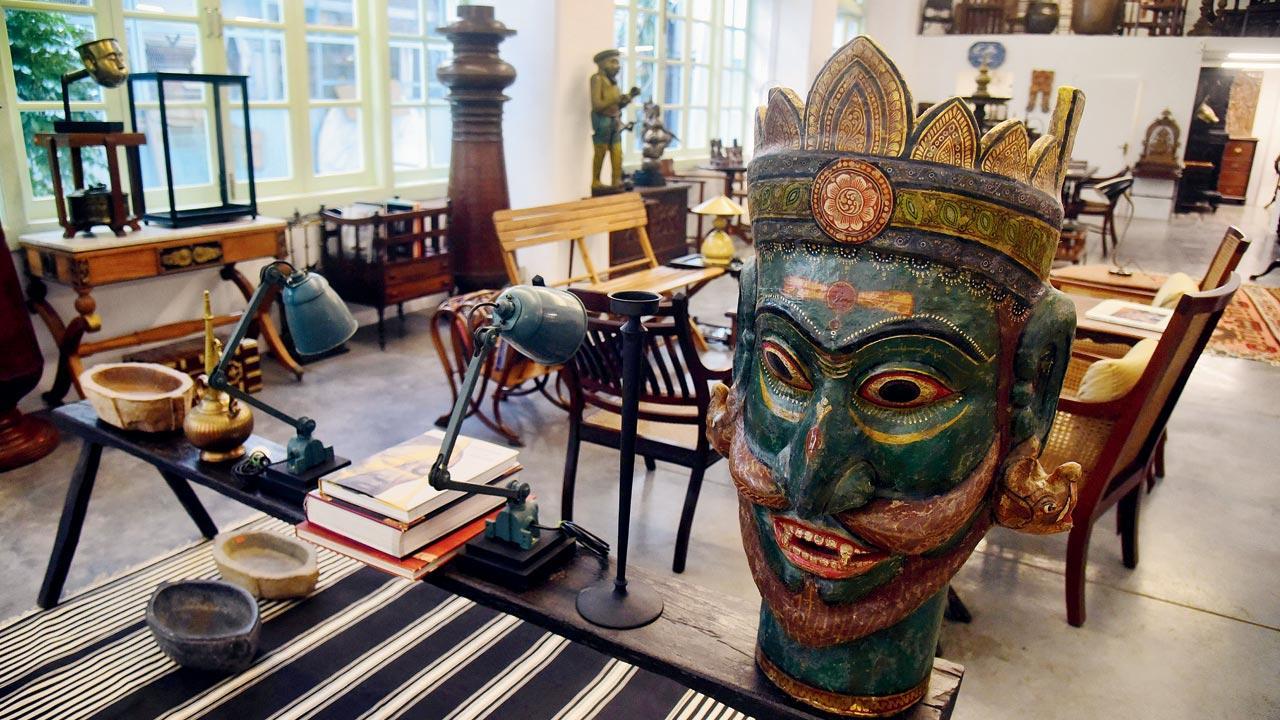
A strong and ferocious painted head of Ravana from the eastern coast of India rests on a dark mahogany bench at the atelier’s entrance. This ceremonial head was made in a uniquely curious way, where the sculptor carved relevant features on local soft wood from Orissa, and wrapped a fine cotton overlay around it. He then proceeded to paint in all the features with vegetable dye. This intricate form of craftsmanship is said to have been popular in different parts of India. Pics/Shadab Khan
Last year, after over three decades in Tardeo, the Moorthys found themselves in need for a new home for their antiques warehouse as their property readied for redevelopment.
“We looked around for a while—it’s hard to find a spacious place with an approach road wide enough to accommodate moving trucks,” points out RK Moorthy, as he welcomes us through a breezy walkway flanked by frangipani trees. This is the new atelier he shares with his wife, Jacinta, which houses their stores, Moorthy’s and Pooranawalla respectively.
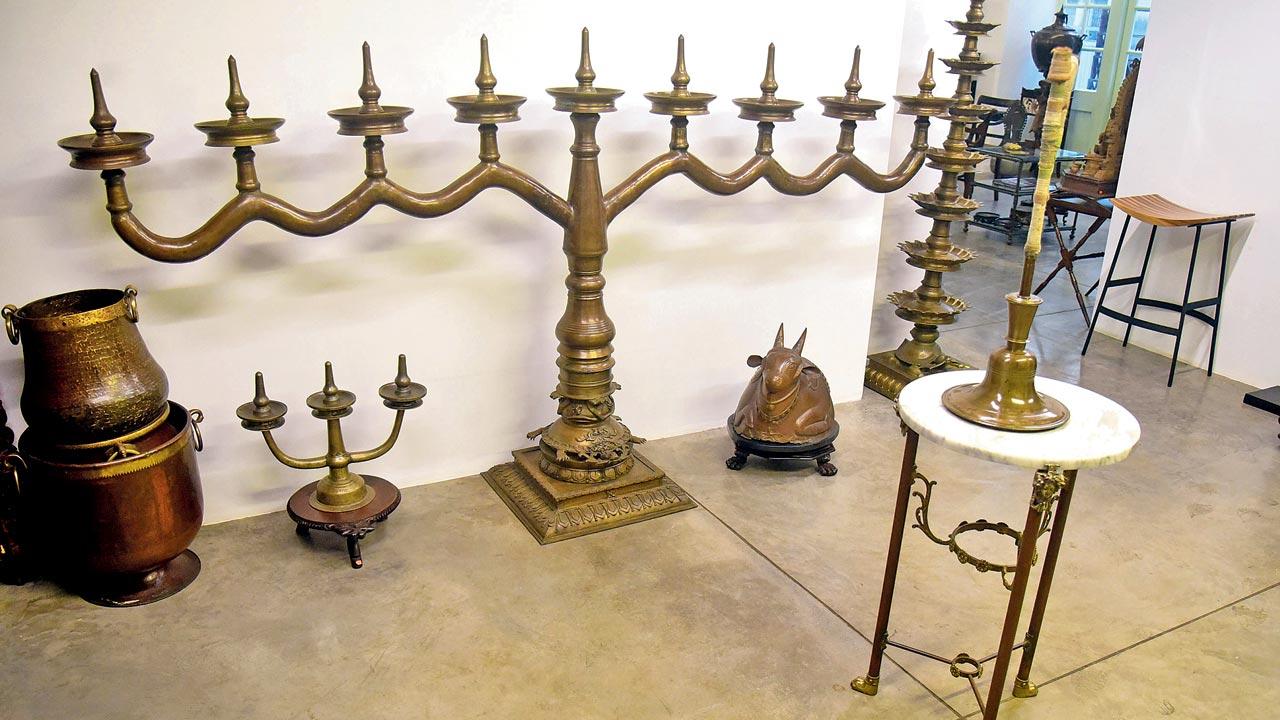 A cast-bronze diya from Kerala echoing the form of a banyan tree with its hanging aerial roots. A tricky skill would have been required to craft this, pairing the correct weight with the type of alloy to hold such a grand piece together
A cast-bronze diya from Kerala echoing the form of a banyan tree with its hanging aerial roots. A tricky skill would have been required to craft this, pairing the correct weight with the type of alloy to hold such a grand piece together
Located in the historic Examiner Press Building on Dalal Street, in two spaces that once upon a time housed its eponymous printing press, the sprawling atelier with high ceilings displays their sizable collection. The mezzanine balconies above store their burgeoning lot of antiques and objets d’art; and a shed outside has been converted into a workshop. An adjoining shopfront is being prepared for smaller keepsakes and artefacts.
“The art district of Kala Ghoda is a happening and sought-after space steeped in history,” beams Jacinta as she shows us around, “and we were thrilled to be a part of it!” “The place was neglected for 15 to 20 years. Everything had to be restored or reinforced, but we haven’t made any structural changes. We managed to get it up and running pretty quickly, sometimes even taking on two shifts,” chuckles Moorthy.
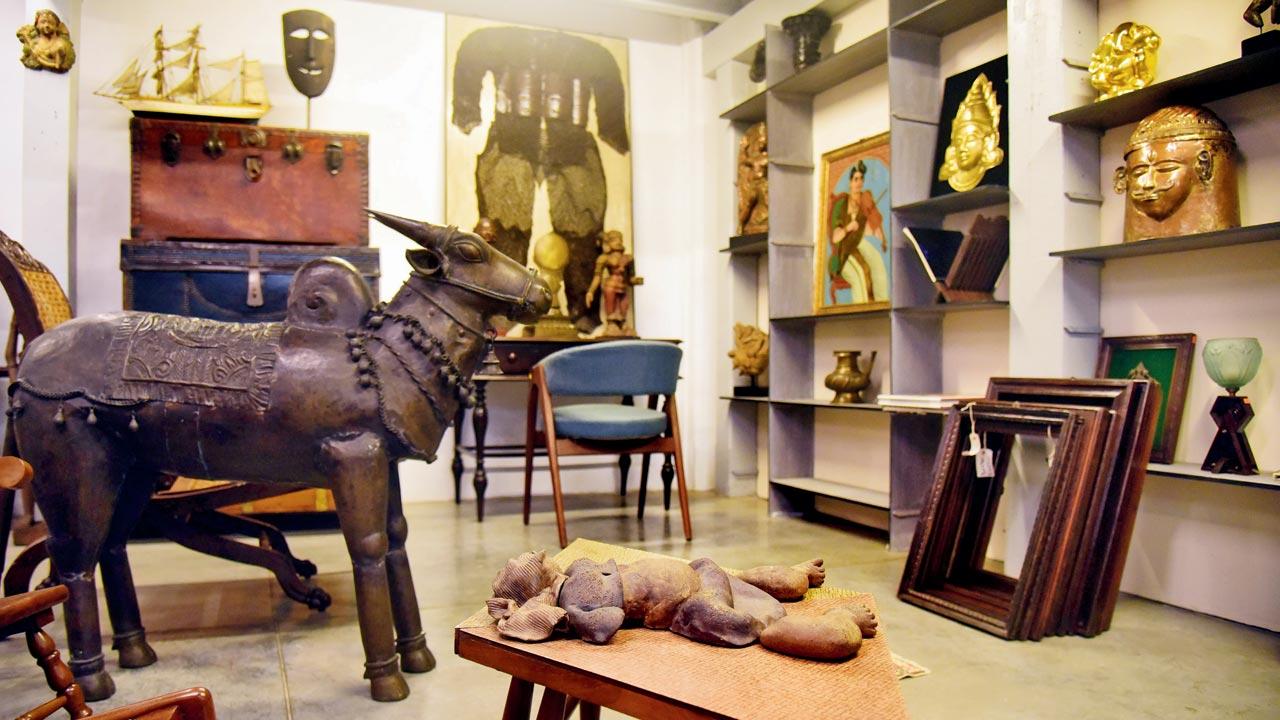 A statue of Nandi displaying a rare method of casting and repoussé within the same sculpture, which was found mainly in the north eastern part of Andhra Pradesh
A statue of Nandi displaying a rare method of casting and repoussé within the same sculpture, which was found mainly in the north eastern part of Andhra Pradesh
As we peep out of the restored floor-to-ceiling doors and windows repainted in soothing seafoam, it’s hard to envision what the space was like a year ago, as the couple describe it with crumbling iron grills and collapsing gates. Sunlight floods each room. The original steel girders and wooden columns—once strong enough to hold up the printing machinery—now create mood spaces where the couple choreograph furniture.
“Unlike the previous space,” says Moorthy, “which was also massive, everything is more curated and displayed to be more visible. We’ve purposely tried to not overcrowd any corner.” The new place is also more accessible to a younger audience, something he and Jacinta bore in mind while designing. “Anyone who walks in,” he continues, “be it an experienced collector or an ardently interested newcomer—will get the chance to explore, discover and see each detail and story of pieces from all over the country. This is what always sparks an interest.”
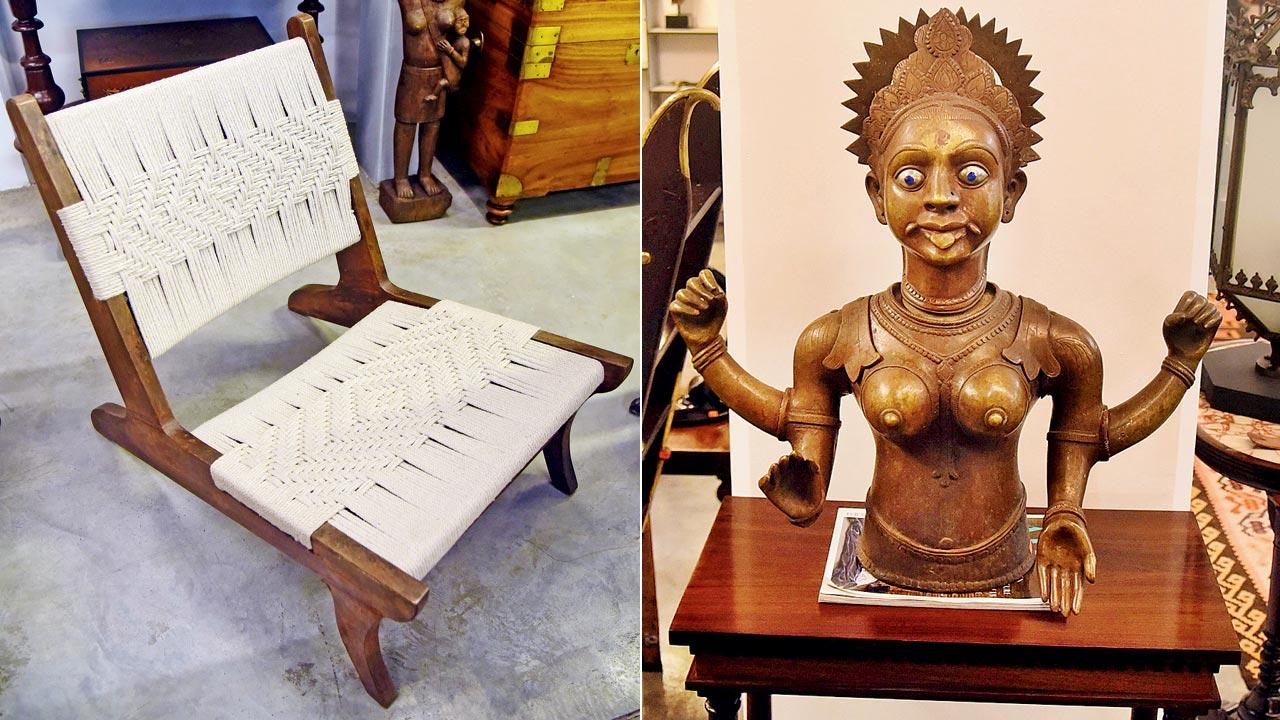 Part of a pair of mid-century Scandinavian low teak chairs from the 1950s, the thick rope weave makes these extremely comfortable for sitting. “The European furniture designers of that era were keenly aware of elegance and style, and revolutionised chair designs, as they were tired of heavy wooden seating, which, according to them, was overly decorated,” says Jacinta; (right) A cast bronze bust of the Hindu goddess Durga, which displays silver inlay eyes with painted pupils. The head and torso have been cast in two parts in Karnataka
Part of a pair of mid-century Scandinavian low teak chairs from the 1950s, the thick rope weave makes these extremely comfortable for sitting. “The European furniture designers of that era were keenly aware of elegance and style, and revolutionised chair designs, as they were tired of heavy wooden seating, which, according to them, was overly decorated,” says Jacinta; (right) A cast bronze bust of the Hindu goddess Durga, which displays silver inlay eyes with painted pupils. The head and torso have been cast in two parts in Karnataka
While the younger generation leans towards mass produced goods bought at the click of a button, Jacinta is quick to point out that a generous number of them are exposed to the older ways of crafting things, finding value in preserving a piece of history in their homes. Through her Instagram account (@pooranawalla), collectors—some in their late 20s—are fed a steady stream of long forgotten techniques which craft artefacts in a methodical, loving and even curious way.
“I think we don’t give the younger generation much credit,” says Jacinta. “They bring a fresh perspective to old things, come with very little baggage, are happy to be straightforward and ask lots of questions. They think out of the box, aren’t as stuffy about learning new things, and share their ideas and thoughts along the way. We’re not in the business of lecturing people about history—we’ve created a space for talking, dialoguing, exchanging views, and discovering stories that echo one’s personality or heritage.”
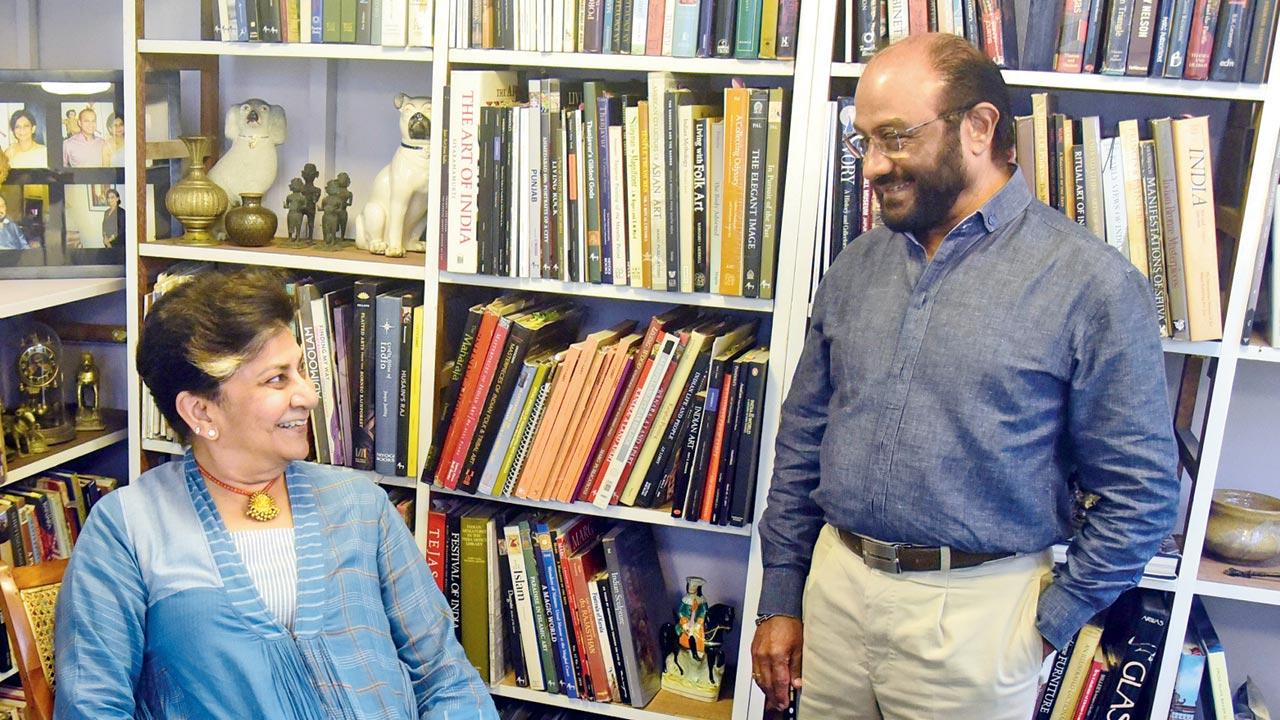 Jacinta and RK Moorthy
Jacinta and RK Moorthy
As we look around at the treasure trove that one can only compare to Aladdin’s Cave of Wonders, we’re captivated by Moorthy’s story-telling of each piece, and his complex knowledge—a walking oral museum. While his wife calls him the Maestro, pointing out that most of this information is largely undocumented, Moorthy humbly says, “It’s hands-on experience. When you’re interested in something, you pay more attention to it. What makes it special? Is it the style, the material or age? I’ve learnt a lot while travelling to the remotest parts of the country over the decades, speaking to craftsmen and kaarigars. If you sit with these pieces long enough, you’ll be able to uncover their stories. There’s also no prototype for restoring each piece, they require individual treatments or preservation methods.”
In a world that’s so fast-moving, the atelier is holding a stitch in time. “I’ve always said we are not sellers, we are custodians—that’s how it will always be,” says Jacinta. “Eventually, the people who buy into the history of a piece become the custodians. It’s a story we pass on. It’s very different from retail therapy.”
Looking to the future, her eyes light up as she shares how the space will bring like-minded people together through book clubs, tastemaker gatherings and, hopefully, collaborations with other arts. “We’ve had the most memorable run for over four decades,” says Moorthy, “and, in a way, this new space is our swan song bringing together the volumes of all our work.”
What to look out for if you’re interested in antiques
1. Never rush into buying anything or picking up the first piece you see. Take your time to know its history, the materials it is made of, the style, and why it is priced at a certain value.
2. Always buy from a reputed dealer. A seasoned dealer will be straightforward about their collection, and have an open and patient dialogue. You should never feel pressured into buying something or be shy about asking the price.
3. Antiques are valued at a certain price for a reason—the materials, age, restoration process, and the intricacy of craftsmanship. A dealer should be able to educate you about this.
4. Always look for a piece that resonates with you personally or echoes your heritage.
5. Never buy something to recreate a look or worry about it fitting in your home. If you love an antique, you will always find a place for it.
 Subscribe today by clicking the link and stay updated with the latest news!" Click here!
Subscribe today by clicking the link and stay updated with the latest news!" Click here!










